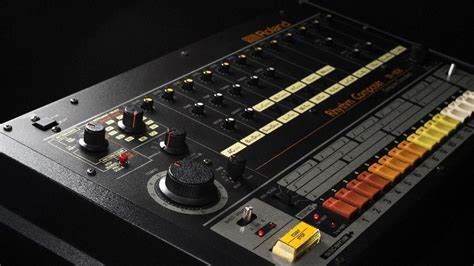By Michael Derrett
In his article, ‘The Meaning In The Mix: Tracing a Song Narrative In “When The Levee Breaks”’ (2012), Aaron Liu-Rosenbaum demonstrates how the application of the concept of phonographic staging (the idea refined by Will Moylan (2002)), and other applications of music production techniques helped to form a ‘sonic narrative’ in the song ‘When The Levee Breaks’ by Led Zeppelin. Liu-Rosenbaum states that ‘sounds can be heard as ‘characters’’ within the context of the recorded track, and as such, can support the lyrical content and ‘story’ of the song (Filimowicz and Stockholm, 2010, 13).
Following this broad concept, this essay will discuss how specific production elements in Pink Floyd’s The Dark Side Of The Moon can be interpreted, firstly in terms of tracing a narrative throughout the album as a whole, and then within selected individual songs on the album.
The Dark Side Of The Moon was recorded at London’s Abbey Road studios between 1972 and 1973, and was released on March 1st 1973. It could be said that the album helped to popularise the notion of the concept album, standing as it does as a coherent body of work which can be thought of as a whole work of art; the tracks of each side flow seamlessly, and altogether form an identifiable subject matter and narrative structure.
The ‘story’ of the album is commonly interpreted as that of a human life experience, with each of the five songs on each side representing various stages or factors that occur within a lifetime, and, in the words of lyricist, bass player and vocalist Roger Waters ‘whether they push you towards insanity, death, empathy, greed, whatever’ (Classic Albums: Pink Floyd; The Making of The Dark Side Of The Moon, 2003). The theme of insanity is particularly notable, as it is apparent that it was inspired by the band’s former principal songwriter Syd Barrett’s descent into mental health problems and his departure from the band in 1968.
The album opens with ‘Speak To Me’, which can be thought of as an overture; bringing together and previewing multiple elements of the album, which plays out in just over a minute before segueing into the first song proper, ‘Breathe (In The Air)’. The first sound heard is that of a kick drum, processed with a gated reverb, repeating a pattern which gives the impression of a human heart beat. Other sounds are then introduced, including sampled ticking clocks (also used on fourth track, ‘Time’), snippets of voices and maniacal laughter (which are used throughout the album), a simulated ‘vehicular’ sound, as well as sampled sounds of coins in a container, ripping paper, and a cash register (all of which form the rhythmic bed introduction to the first track of side two, ‘Money’).
Following the proposed concept of the album following a narrative of a human lifetime, it could be suggested that ‘Speak To Me’ is a representation of a pre-birth state, in which the listener is placed in the position of the unborn foetus; with the ‘heartbeat’ as the first-heard and predominant sound, placed relatively centrally in the stereo field. The ‘heartbeat’ is then joined by all of the previously mentioned sounds, panned and placed in various spaces throughout the stereo field, ‘surrounding’ the listener from all sides, giving an impression of a ‘preview’ of the various sounds created in the world outside of the womb.
This interpretation of ‘Speak To Me’ as the pre-birth state may be further strengthened by the presence of the ‘vehicular’ sound. This sound not only shares a similar timbral quality to that of machinery or some sort of vehicle, but it also moves (is panned) back and forth between left and right, creating a sense of motion. This sound could be said to bear a striking similarity to that of the mechanics of a roller-coaster as the carriages make a climb before the first descent; perhaps a metaphor illustrating how birth and life reflects this moment of a roller coaster ride’s beginning and subsequent journey. The ‘shriek’ heard between ‘Speak To Me’ and ‘Breathe (In The Air)’ could also be interpreted as the cry of a newborn baby, and simultaneously, the ‘cry’ of a person beginning a rollercoaster ride.
With the beginning of ‘Breathe (In The Air)’, we hear a reversed piano chord transition into the first beat of the track. The guitars, bass, keys and drums that begin on this first beat provide a timbral change that, along with the crescendo of the reversed chord from the piano, signal a change from one state to another, or a movement over a threshold; further strengthening the concept of ‘birth’, this could be interpreted as the passage from the womb to the outside world. Lyrically, the track also may be interpreted in a similar way;
Breathe, breathe in the air
Don’t be afraid to care
Leave but don’t leave me
Look around and choose your own ground
For long you live and high you fly
And smiles you’ll give and tears you’ll cry
And all you touch and all you see
Is all your life will ever be.
It could be said that these words appear to be written in the context of parental guidance, or even simply thoughts on life, from a person of experience to someone with their life ahead of them.
It may be worth noting, also, the nature of the timbres and registers of the instrumentation that feature on ‘Breathe (In The Air)’, and how they may be seen as to support this proposed narrative. In the right channel a Fender Rhodes electric piano can be heard, with a mellow tone and relatively sparse part to play in the track, it plays the role of a ‘bed’ on top of which the lead parts take a more prominent role. Furthermore, in the left and right channels and centre we hear multi-tracked electric guitars, and pedal steel guitar, played in various ways; picked notes and strummed chords feature in the left channel laden with modulation effects, which suggests an impression of movement further to that of the musical elements alone, while slide guitar and pedal steel guitar feature in the right channel and centre.
Dark Side of The Moon recording engineer Alan Parsons has spoken of his preference for miking-up guitar amplifier cabs from a relatively distant point (Gallagher, 2012) in order to capture the sound of the whole speaker, as opposed to close-miking the speaker, which may often result in a more harsh, attack-present sound, especially if the microphone was to be positioned close to the centre of a speaker cone. It may be suggested, therefore, that Parsons’ recording technique lends the track a warmth in the instrumental parts that compliments the suggested narrative.
The portamento playing of these guitars minimises the rate and amplitude of any transients in the sound, therefore creating a softness and mellow tone that would otherwise not have occurred. The enveloping nature of this variety of warm, often sweeping sounds could be suggested to reflect the care and gentle attention that is given to a newborn baby. Expanding the concept further, could lead the listener to interpreting the guitars/keys in this particular song as representation of the ‘newborn’, and therefore the vocalist, as suggested by the lyrics, as the ‘parent’ or ‘guardian’.
‘On The Run’, the third track on the album, can be regarded as the point in the narrative at which the ‘character’, whose life is playing out across the album, must enter onto the treadmill of a modern person’s lifestyle. Sounds heard on this track include the EMS VCS3 and Synthi AKS synthesiser, on which an 8-note sequence was created, as well as a white noise generator to create the ‘hi-hat’ sound, which was then sped up to produce the fast-paced rhythmic pattern which is heard throughout the majority of the track. The combination of the Synthi AKS and VCS3 synthesiser parts are constructed to perhaps give the impression of a vehicle passing the listener; a doppler-effect-like sound is created, in which it appears that the source of the sound waves being produced is moving with respect to the listener (The Physics Classroom, 2016). This, in addition to the tempo (165 BPM) of the sequenced synthesiser parts, could be said to produce a sensation of fast motion and breathlessness.
In addition to these elements is the sound of a studio assistant running around the Abbey Road studio’s reverb chamber. We hear the rapid footsteps of the ‘runner’ on the room’s floor, as well as his heavy breathing, and of course these reflected sounds within the chamber itself. As Zak (2001, 84) writes that reverberation has the capability to remove the listener from the sound world, it could be suggested that this has a part to play in telling the narrative of the album, in that, for the first time, the listener is experiencing one of the many factors of life that can ultimately lead to insanity or death, and this ‘distancing’ of listener from the sound world is a reflection of a beginning of mental illness.
Towards the end of the track (3:03), the sequenced synthesiser sounds come to an end with a distorted explosive sound, preceded by distorted vocal ‘maniacal’ laughter. As Robert Walser (1993, 42) states, distortion acts as a sign of ‘extreme power and intense expression’, adding to the sense of implication of something of great distress (in this instance, the incessant fast pace of modern life) occurring within the narrative. As the ‘explosion’ fades, we once again hear the ‘runner’ in the reverb chamber, suggesting the unceasing nature of existence of the ‘treadmill’ of life.
‘Time’, the penultimate track on side A of the album, begins by surrounding the listener with a multitude of clocks ticking and chiming; each sound placed in it’s own space throughout the stereo field, perhaps to give the impression of another factor of modern life that is inescapable. It is worth noting also, that the vocals on this track could be said to be more demanding on the voice of the singer than what has been heard up to this point; the ‘strain’ in the voice in the opening verse (2:18) results in natural vocal compression, in which the folds of the vocal cords are pulled relatively tight, naturally distorting the sound to some degree. This could be interpreted, in terms of the overall narrative, as a further consequence of the hardships (in this case ‘time’ being the particular factor) that the character in the narrative is facing. This sense of building anguish is built upon further, in that the guitar tone (heard at 3:18) is also more distorted than those heard previously in the album.
The first side of The Dark Side Of The Moon ends with ‘The Great Gig In The Sky’, which can be seen as a conceptualisation of death. This is made clear with the spoken voice snippet in the introduction, stating ‘I am not afraid of dying […] why should I be frightened of dying?’. The track’s most prominent feature is that of Clare Torry’s non-lexical improvised vocal performance, which could be said to be interpreted as to sound at once orgasmic and/or distressed. In the context of the suggested overall narrative, it could be said that, although death is the most apparent theme of the song, perhaps the open-to-interpretation, improvised nature of the performance and absence of sung lyrics is a representation of how a deterioration into mental health problems or insanity can be perceived as some form of death in a person.
‘Money’, the side-two opener on the album is notable for its unconventional 7/4 – 4/4 time signature. The groove created by the 7/4 time signature is often felt to have an ‘unfinished’, or ‘on the edge’ quality, which could be said to reflect the fact that money is not an easy, free-flowing concept to negotiate for many people. The change, mid-way through the track, to a more easy-flowing, conventional 4/4 time, and the subsequent change back to 7/4 could also be interpreted within the context of a narrative to represent an ebb and flow of money that can be a common experience in modern life.
‘Brain Damage’, the penultimate track on the album, speaks of ‘the lunatic … on the grass’, and can be said to be on the theme of ultimately descending into insanity. In a mirroring of Liu-Rosenbaum’s (2012) interpretation of the ‘breaking levee’ in Led Zeppelin’s ‘When The Levee Breaks’, it could be said that the ‘breaking’ of the ‘character’ in the narrative of the album occurs at the point at which the lyrics state ‘And if the dam breaks open many years too soon…’. At this point, the relatively light backing instrumentation of guitars, a simple hi-hat pattern, and bass guitar is ‘broken’ with the introduction of much heavier instrumentation, creating a much more dense overall sound and ‘filling out’ the sound stage, with a Hammond organ, full drum kit, and full backing vocals.
While my understanding and interpretation of the themes and overall narrative of Pink Floyd’s The Dark Side Of The Moon may be commonly accepted amongst the listening public, it may not always be immediately apparent that the lyrical narrative in individual songs and over the course of the album can be seen to be supported by a myriad of production elements. Whether these production ‘signposts’ are relevant, support or distort the perceived meaning, or were intended by the producers of the work, are all questions that can be open to interpretation in their own right, my standpoint is that they can only serve to add further interest to the art.



